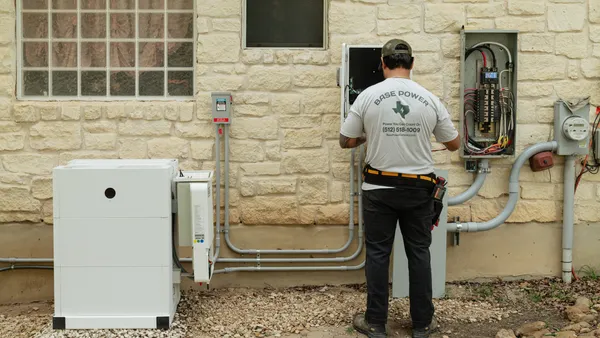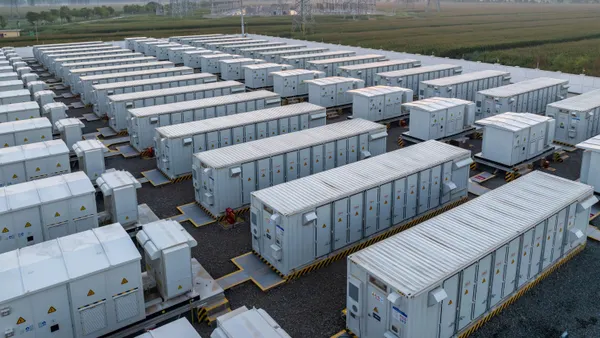Recent changes in the economics of the energy storage are causing a shift in the market for lithium-ion batteries, which could accentuate China’s position in the global energy storage market.
Surging demand has led to a shortage of nickel manganese cobalt (NMC) batteries, giving lithium iron phosphate (LFP) batteries a chance to gain market share.
"The current supply tightness for NMC batteries is opening up doors for LFP batteries as they are seeing a growing interest from storage vendors for not just power but also energy applications," Mitalee Gupta, energy storage analyst at Wood Mackenzie Power & Renewables, told Utility Dive via email.
In the short term, that shortage could lead to a slowdown in expected price declines for batteries. Li-ion battery rack prices declined by more than 20% year-over-year in 2015 and 2016, and came down by almost 15% in 2017, according to Wood Mackenzie.
The research firm forecasts another 14% decline in prices in 2018, but noted that price declines have "slowed significantly over the last quarter," in the most recent Energy Storage Monitor.
"There aren’t enough cell manufacturing plants operational today and the all of the current production capacity has already been contracted."

Mitalee Gupta
Energy storage analyst, Wood Mackenzie Power & Renewables
Choosing battery chemistries
Li-ion batteries dominate the energy storage market, but they are not all created equal. They are differentiated by the chemistries used in the battery’s cathode. There are about a half dozen li-ion chemistries, each with their own subcategories and their own advantages and disadvantages.
In 2017, lithium cobalt oxide (LCO) and LFP batteries had about an 80% share of the global li-ion market. LCO is used mainly in smartphones and computers.
Since 2015, NMC chemistry has become widely used in electric vehicle (EV) applications. NMC chemistry has also been used in stationary storage markets, and the combined demand from those uses is outstripping supply.
"There aren’t enough cell manufacturing plants operational today, and the all of the current production capacity has already been contracted," Gupta said. As a result, lead times for battery availability for energy storage applications have increased.
It is a different story for LFP batteries, however. Typically used in power tools and industrial applications, they have been used more widely in electric buses since 2015.
"There is availability of LFP batteries today, largely coming from Chinese vendors, where these batteries have traditionally been used in e-buses and e-trucks," Gupta said.
Gupta expects the NMC shortage issues to be resolved as battery manufacturers ramp up production and new cell manufacturing plants come online over the next few quarters. Then, she said, battery price will continue to decline as vendors achieve economies of scale.
In the meantime, LFP manufacturing capacity will grow, pushing down prices even as lead times for NMC battery availability stretch out to six or even nine months. That will lead to an increased interest in LFP batteries for use in energy applications for in front-of-the-meter storage projects, Gupta said.
China rising
The most immediate consequence of this shift in battery chemistry is that Chinese companies are attracting interest from U.S. storage vendors, Gupta said.
Until recently, Chinese battery maker BYD was the biggest LFP manufacturer supplying batteries for front-of-the-meter storage projects as well as electric buses, but now system integrators are looking at several Chinese vendors to secure LFP batteries.
Historically, most li-ion battery cells were made in Japan or South Korea by manufacturing giants such as Panasonic or LG Chem. Now, Chinese vendors are competing head on with those manufactures both in terms of products and state of the art manufacturing facilities.
In 2017, China launched its first national energy storage policy. In the first half of 2018, China announced new energy storage projects totaling 340 MW, which is nearly equal to the country’s existing energy storage capacity of 389 MW at the end of 2017, according to the China Energy Storage Alliance.
The country is also dramatically ramping up its battery manufacturing capability. China has set a target of having the capacity to produce 121 GWh of batteries by 2020, according to Bloomberg. That compares with a target of 35 GWh for Tesla’s gigafactory when it reaches full capacity next year.
China’s BYD is already the leading manufacturer of EVs in the world, and the country is setting up Contemporary Amperex Technology Ltd. (CATL) to be a leading battery manufacturer with plans to quintuple CATL’s production capacity, putting it ahead of both Tesla and BYD.
Chinese companies are increasing both the NMC and LFP capacity but most of the emphasis is on LFP, according to GCIS China Strategic Research.
One of the vendors looking to China for batteries is Powin Energy.
Powin once was both a developer of energy storage projects and an equipment provider. Late last year, the Oregon company sold over 110 MWh of energy storage projects it had developed to esVolta, completing its transition from the project development company to an energy storage systems and services provider. Powin will be esVolta’s exclusive provider of energy storage systems through 2022.
With its new corporate focus, Powin says it is on track to install or deliver over 32.8 MW / 70MWh of energy storage projects by early 2019. Longer term, the company has contracts to deliver an additional 94.7 MW / 411 MWh of project between late 2019 and late 2021.
Those projects, which all use LFP chemistry, give Powin momentum going into 2019 while competitors continue to face critical material shortages, Geoff Brown, the company’s president, told Utility Dive.
"We are benefiting from the redirection of the NMC batteries to a higher margin market, creating the appearance of a shortage on our side," Brown said.
Some of the large NMC manufacturers are pursuing markets where they can command higher margins, markets that are willing to pay a premium for higher performance such as energy density and battery life, Brown said. NMC batteries typically have a higher energy density than LFP batteries, but energy density is not as big a concern for stationary storage.
Brown said he sees a lot more developers looking at LFP batteries and going directly to Chinese companies. But that is a flexibility that some manufacturers do not have.
"They have to sell what they are manufacturing," he said.
The 'rugged' approach
Brown said he is willing to take the trade off of energy density for the more "rugged" characteristics of LFP batteries: their ability to operate with a deeper discharge cycle and to withstand higher levels of sustained voltage.
NMC chemistry is particularly sensitive to being fully discharged on a regular basis.
"If you do that too often you will violate your warranty," Brown said. LFP, on the other hand, is much more resistant to a full depth of discharge cycle, so typically you have more cycle life, he said.
A storage facility that is serving the peak power market is looking at cycling 50 or 60 times a year. That is quite different from the frequency regulation market or the market for solar shifting where a battery could be subject to a full cycle every day, Brown said.
"Some of the most exciting applications for stationary storage are not high cycling; they are peaking applications."
However, Brown insists "there is no one best chemistry."
"The perfect energy storage system hasn’t been built yet."

Geoff Brown
President, Powin Energy
Brown said the main reason Powin uses LFP batteries is safety. LFP batteries are generally more thermally resistant than NMC batteries. And "because you trust it, you can reduce your costs in other elements" such as thermal controls and safeguards.
"We decided that with the size of our business, we would take a conservative, rugged approach," Brown said. Choice of technology is a function of market price and use case, and "those two things are different for EVs and energy storage and different for different stationary storage applications."
For now, Brown says, he believes "LFP is the right approach," though, he says, "I wouldn't be surprised if in 18 months we had an NMC offering."
"The perfect energy storage system hasn’t been built yet," Brown said. "If we keep reducing costs, developers will find a way to get that to the market."












